Northallerton, North Riding of Yorkshire
Up to 1834
Northallerton's first poorhouse was in the former Guildhall situated at the west of the High Street near the Sun Beck, where Westgarth now begins . Originally erected in 1444, it was the home of the Quarter Sessions between 1558 and 1730, then becoming the parish poorhouse. A parliamentary report of 1777 recorded that the parish workhouse at Northallerton could accommodate up to 28 inmates. Workhouse inmates were occupied in spinning for the local linen industry and different classes of inmate were only segregated when it came to sleeping quarters. Conditions were apparently squalid — in 1816 it took three days for the workhouse yard to be cleared of rubbish (Hastings, 1996).
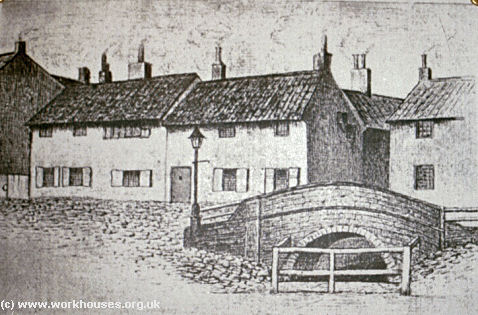
Northallerton parish workhouse.
The 1777 parliamentary report also listed a workhouse at Danby Wisk for up to 8 inmates. By 1802, workhouses had been set up at Brompton and Osmotherley.
After 1834
Northallerton Poor Law Union was formed on 23rd February 1837. Its operation was overseen by an elected Board of Guardians, 55 in number, representing its 52 constituent parishes and townships as listed below (figures in brackets indicate numbers of Guardians if more than one):
West Riding of Yorkshire:
Ainderby Myers, Ainderby Steeple, Aiskew, Appleton-on-Wisk, Bedale, Birkby, Borrowby, Brompton (2), South Cowton, East Cowton, Crakenhall, Crosby, Danby Wisk, Deighton, Ellerback, Firby, Gueldable, Hackforth, West Harsley, East Harsley, Hornby, Hutton Bonville, Killerby, Kilpin, Kirkby Fleetham, Landmoth with Catto, Langthorne, Great Langton, Little Langton, Morton, Northallerton (3), Osmotherly, North Otterington, Rand Grange, Romanby, Scruton, Kirby Sigston, Little Smeaton, Great Smeaton, Silton Nether, Silton Over, Sowerby-under-Cotliffe, Thimbleby, Thirntoft, Thornton-le-Beans, Thornton Watlass, Warlaby, Welbury, West Rouncton, Whitwell, Winton, Yafforth.
Later additions: Cotlcliffe, Lazenby, Leake (all from 1858).
The population falling within the Union at the 1831 census had been 16,459 with parishes ranging in size from Crosby (population 37) to Northallerton itself (3,004). The average annual poor-rate expenditure for the period 1834-36 had been £6,209 or 7s.7d. per head of the population.
From the outset, the operation of the Northallerton Union was troubled by local party politics. The Guardians representing twelve townships in the Whig-dominated Bedale area (Ainderby Myers, Aiskew, Bedale, Crakenhall, Firby, Hackforth, Killerby, Kirkby Fleetham, Langthorne, Rand Grange, Scruton, and Thornton Watlass) agitated to have their own union and constantly disrupted proceedings until they finally got their way in March 1839.
Like the majority of new unions, Northallerton had plans to erect a new union workhouse. In the meantime, the existing parish workhouses continued in operation at Northallerton for housing the able-bodied, and at Brompton for children and the aged. Following the departure of the Bedale Guardians, opinion in the Northallerton board swung against a new building. Opposition intensified in 1840 with a depression in the linen industry. Brompton workhouse closed the same year, leaving just the old Northallerton parish workhouse which could only accommodate 42 inmates — it was described as "one of the most wretched poorhouses in England" with classification and segregation of the inmates severely lacking. Physical conditions were extremely cramped with small and badly drained yards and a stagnant stream close by. The old building continued in operation for another 15 years and was frequently the subject of scandal with female inmates "entertaining" men from the streets and inmates selling workhouse property.
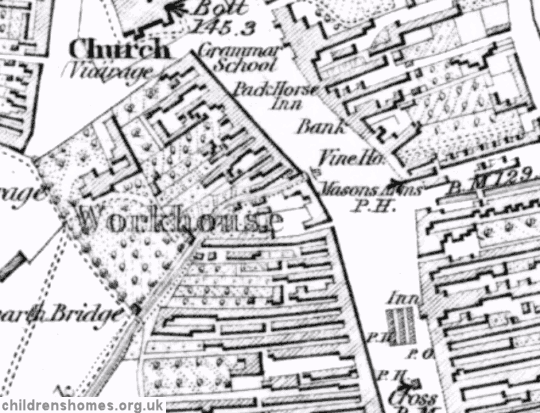
Northallerton workhouse site, 1855.
Finally, in 1856 the Guardians agreed to build a new union workhouse. It was erected in 1857-8 on a 1.7 acre site known as "Ware Banks" — the southern part of "Friarage Fields" where a medieval Carmelite Friary had stood. The site included the Horse Pond — a former watering stop for stagecoach horses from the busy Great North Road.
The site location and layout are shown on the 1938 map below by which time the workhouse was officially known as Sunbeck House Public Assistance Institution:
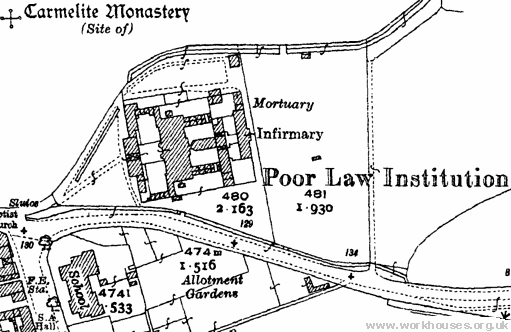
Northallerton workhouse site, 1929.
The new building, constructed in red brick with slate roofs, cost £5,000 and accommodated about 120 inmates. It was designed by "Mr Moffatt" — presumably William Bonython Moffatt who, with his partner George Gilbert Scott, had designed many workhouse buildings in the late 1830s, particularly in the south-west of England for unions such as Bideford.
An early view of the workhouse is shown on this postcard from around 1913.
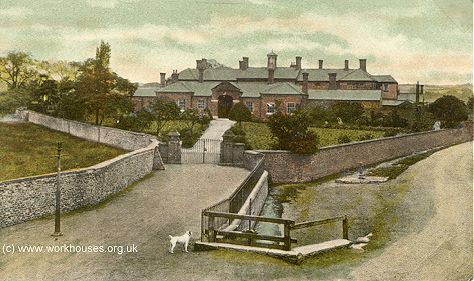
Northallerton general view from the south-west, c.1913.
© Peter Higginbotham.
The buildings consist of a single storey entrance block with a central archway. The entrance block was later extended at each end. To the rear was the two storey main block, with male and female wings to each side and kitchens to the rear.
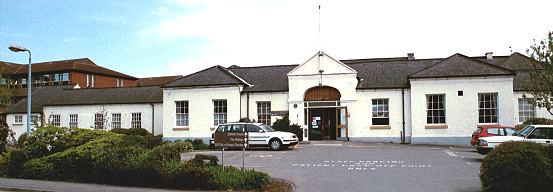
Northallerton entrance block from the west, 2001.
© Peter Higginbotham.
The workhouse infirmary, also later much extended, together with a mortuary stood at the rear.
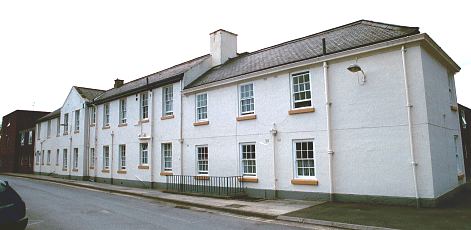
Northallerton infirmary block from the north-east, 2001.
© Peter Higginbotham.
Provision for vagrants at the workhouse was particularly Spartan. No baths were provided, and "casuals" had to break a cwt. of stone to earn their breakfast of a pint and a half of porridge and 7oz. of bread. A new set of vagrants' cells was erected in 1929 the year before the official end of the workhouse system.
During the First World War, military personnel were billeted at the workhouse. During the Second World War, the site became an Emergency Medical Scheme hospital then, from 1943 to 1947, was taken over by RAF Northallerton. In 1948, It became the Friarage Hospital, initially as an orthopaedic hospital for polio victims, then later becoming a general hospital.
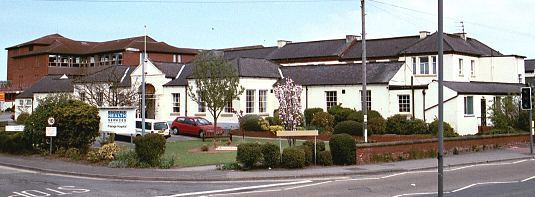
Northallerton general view from the south-west, 2001.
© Peter Higginbotham.
Children's Home
In the 1920s, the union is thought to have established accommodation for up to 16 pauper children at North End, Northallerton.
Staff
Inmates
Records
Note: many repositories impose a closure period of up to 100 years for records identifying individuals. Before travelling a long distance, always check that the records you want to consult will be available.
- North Yorkshire County Record Office, Malpas Road, Northallerton DL7 8TB. Holdings include: Guradians' minutes (1837-1930); Letter books (1882-1930); Inmates examination book (1916-29); Lunatic examination book (1917-30); Register of births (1868-1914); Admission and discharge registers (1837-1930); Register of applications by casuals (1925-1936); Religious creed regsiters (1869-1945); Register of inmates and friends (1906-1931); Master's report books, journals and other records (1845-1940); Register of servants and apprentices (1928-33; Register of admissions (1923-35); Register of removals, discharges and deaths (1926-35); Register of births in Northallerton workhouse 1837-1867.
Bibliography
Links
- None.
Unless otherwise indicated, this page () is copyright Peter Higginbotham. Contents may not be reproduced without permission.


